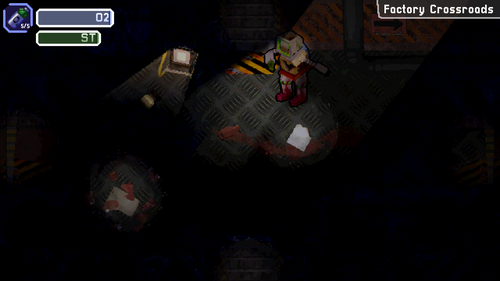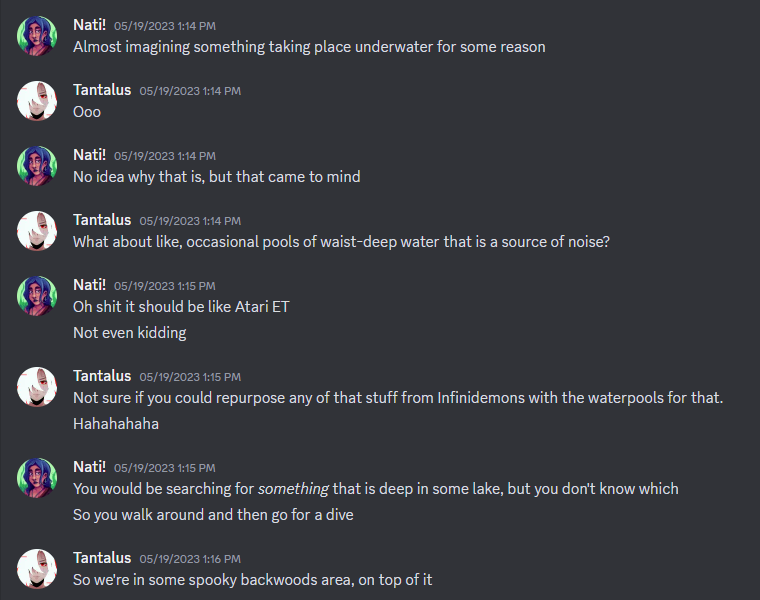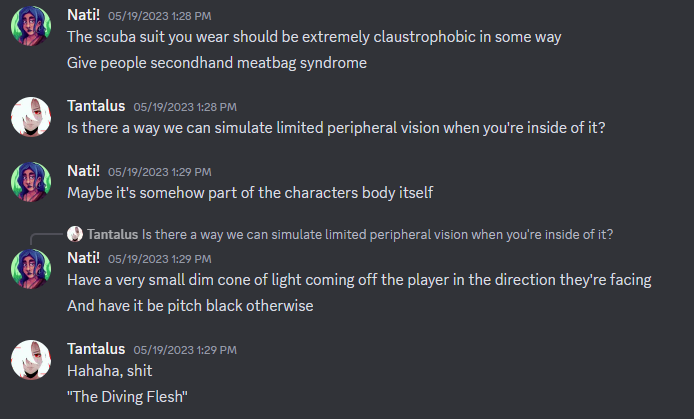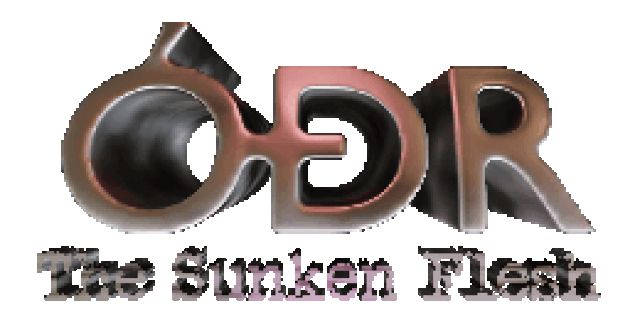Liminal Jam Postmortem

Hey all, Dustin here! Now that we're several days removed from the Liminal Jam, Nati and I figured it might be fun to look back over our 5 weeks of development and go over some highlights from our time working on ÓÐR (pronounced "OH-thur", by the way). Today we'll keep things lite and go over some of the broad strokes -- a surprising amount went into this, and we'll cover more nuanced or technical aspects in future posts.
First-off, we just want to congratulate everyone who participated in the Jam itself. It wasn't the biggest Jam by any means, but that almost made it more exciting in a way because it was easier to get a handle on the work of our peers and anticipate how the ratings would ultimately shake out. We're incredibly proud of this project, so it was really validating to place decently high overall, and to receive particularly high marks in both audio and visuals was also an extremely great feeling. I'm told that Nati and her family celebrated us ranking #1 in terms of gameplay with some steaks, though I can't entirely confirm as mine has yet to arrive in the mail.
Now! Onto the project itself -- the concept for ÓÐR actually slightly predated our decision to participate in the Liminal Jam itself. We were interested in tackling a jam project in general, but hadn't settling on anything in particular. Originally we considered maybe joining one of a handful of horror-themed game jams that were running in a similar timeframe. Out of all of our Jam options, working on a horror game together was speaking the most to us, but as we looked over our schedules and fretted over the possibility that the yet-to-be-revealed themes for those horror jams would conflict with the concept we were already starting to fall in love with, we realized that "liminality" was already something we were going to be toying with in this project, so, it made perfect sense to just double down on that. But, I'm getting ahead of myself. Our core idea for the game, as ideas often do, came from an incredibly stupid place: ET for the Atari 2600.
ÓÐR quite literally started as "What if ET, but damp?" If you're not familiar with how the Atari 2600 ET game is structured, it's pretty straightforward - you explore an small open environment screen by screen, falling into holes to collect items, while avoiding roaming and pursuing FBI agents that do not wish you well. And from there, our core mechanics fell into place; diving into pools of water, collecting various keys to open doors, all while avoiding malicious water spirits. Avoiding being the key word here. We already were pretty confident on the idea of this not featuring direct combat with enemies as a design limitation, so us stumbling into a comparison with a game like ET isn't even that out of left field, it's definitely a game where you feel constantly disempowered by the 'enemies', so, it was honestly a natural place for our minds to go. Regardless of the how, with ET as a shockingly fitting point of reference, our little horror-stealth concept was already sounding pretty compelling, and we immediately began to think of fun things we could do if we kept going in this direction.
From there, we elaborated on that base premise and ran with the ideas it provided. If we're going to go underwater, then surely limited oxygen should be a concern, right? Maybe that's something else you could collect during your exploration? Focusing on that tension became very important to us - the tension of limited oxygen, and of low visibility, and a general unpleasantness associated with the suit. To push that tension and lack-of-comfort even further, we decided to take some small inspiration from another unusual place, Zombi U, with our real-time inventory management. The setting quickly adapted to compliment that, changing from an open field of lakes to a dense and claustrophobic network of tunnels and strange submerged structures. Subterranean exploration implies low visibility, and low visibility gives us an opportunity for things like limited light-sources, and flares made a ton of sense for exploring dark flooded caverns; a useful tool with limitations baked in due to the constant treks underwater.

With this core loop and premise in place, we established a handful of other design elements we thought would play well with these mechanics, particularly as they related to the game's basic stealth mechanics; patrolling enemies with limited vision, but the ability to hear player actions and investigate suspicious noises, gave us a base level of interactivity between the player and our enemies that we thought was really fun. We definitely wanted to have more than simply running and hiding, and we would joke frequently that the inclusion of something as simple as the bottle that the player could throw was starting to make ÓÐR feel like a mini-immersive sim. To be honest, we were leaning into that feeling almost from the get go, with things like object persistence between rooms making their way into the project rather quickly (the odd cat fellow in a couple of the videos below was our placeholder character, taken from an older prototype of Nati's - INFINIDEMONS - which she took some base code from for things like character movement and the water to help get the project up and running).
But, when it comes to the games I like to make the most, there's more to account for than just the gameplay itself. Even with the limited time to develop this, trying our best to establish a strong sense of place/mood, as well as a compelling narrative, were extremely important to me. My narrative "ambitions" sadly didn't pan out for this initial release, but, a lot of time was spent on that angle of the game (I spent a ton of time researching relevant mythology and the culture of the North Germanic peoples, just as an example) and it did end up informing a lot of other decisions about the presentation that did find their way into this prototype. I mean, it's even in the name - literally!
Really, our initial vision for this in terms of the scope beyond these base mechanics was far too big for the jam - especially considering the fact that we originally only intended on developing this for about 2 weeks. Just speaking personally, I am as proud of my narrative concepts as I am the other aspects of the game we did ship, and would like to return to both them and ÓÐR in general one day, but for now you could think of this release as our 'prologue' to our 'prologue' of that original idea. You can see some remnants of this larger vision in things like the unused slots in the inventory screen, as well as the complexity of the text and dialogue system - complexity that was meant to feature mostly in scenes and conversations with other characters.
From a presentation perspective, I think this all paid off very well. I think the game looks and sounds incredible, despite a lot of this being new territory for Nati and myself as developers. I've really no reason to complain, and in the end it was the right call to cut things back and focus on what we knew we could deliver on confidently with the time we had. Story and theming can be a lot trickier to nail, and I certainly felt a lot better about saving those elements for a potential future rather than putting out a really clumsy and rushed take on those concepts here and now.
This desire for a beefier scope came from another obvious point of reference for us, the classic Resident Evil and Silent Hill games. While our game isn't a 'traditional' Survival Horror game by any means, we definitely echoed that design as much as we could with ÓÐR. A fully limited inventory ala Resident Evil wasn't something we were interested in replicating here, but some degree of item or resource management was vital to capturing the tension we wanted. I think I maybe overcorrected a bit with the number of pickups present, but much like my concerns with executing on a narrative with the time we had, I'd rather the game be a bit too easy right now instead of annoyingly difficult. Balancing for difficulty can be such an incredibly time-consuming process, and well, we obviously didn't have the time to spare. Fun fact - did you know we submitted the initial build of ÓÐR to the jam with only about 90 seconds to spare? What was I saying before about us wanting to spend only 2 weeks on this at one point?
Anyway, the general framework and pacing of games like this (and in the case of Silent Hill, the incredibly rich atmosphere) was also constantly on my mind as I designed the game's levels. I'll get more into the specific of this process in a future post, but for now I just wanted to highlight the interesting dynamic between the needs of the jam and my own needs as a designer. With titles like classic Resident Evil especially, the elegant reuse of space is a big part of the appeal. Becoming more familiar with a space, and the threats that inhabit it, leads to interesting decisions over the course of an entire journey through that game-world. I believe that in a lot of ways, this focus on a dense and interconnected environment, with a lot of decisions to be made on not only where to go but how to get there, is fundamental to the strengths of survival horror games. This kind of structure really appeals to me -- I think it's a lot of fun to design for, and I really wanted to build that kind of space. But, I also wanted to see if I could successfully manage an interplay between this density and liminality.
Liminality implies a sense of transition, and in a friction between the familiar and the unfamiliar. Asking the player to become more familiar with a space seems almost counter to that liminal feeling on paper, but I feel like we were able to play with this in a few interesting ways - some of which I'll get into in that future level design post. The real solution though I think came in the form of the final piece of our aesthetic puzzle; the underwater sections.
Our project ranked pretty low in the 'liminality' category, and in a lot of ways I do understand why. It is drastically lower compared to our placement in other categories, and at first glance you might be lead to think it was kind of an afterthought for us, but I feel like it didn't come up a ton during our design discussions because the 'solution' felt so natural to us. We really wanted to not only create a contrast between the surface and the underwater sections in terms of how dangerous they were, but also by really leaning into the otherworldly quality of the depths. We landed pretty early on the 'shower' or 'pool' tile aesthetic for those sections, a popular favorite for liminal artwork. But It wasn't just about the look - from the music to the ways we tried to amp up the claustrophobia when in those sections, we really tried to make our underwater sections feel extremely dreamlike, and more importantly, transitory. In terms of my design, I wanted to use them as literal transitions between phases of the game, with a long and protracted underwater section needing to be struggled through to get most major keys. I suppose you could argue that this take on a sense of liminality is less overt than a lot of others, which is entirely fair, but to me at least this did feel like a very natural direction to take that concept. I understand why you may not agree though, it's definitely not a very 'traditional' take on the aesthetic.
At any rate, I think I've definitely gone on long enough! We'll be doing a few more posts like this going over some more specific aspects of the project - maybe Nati will be here next time to talk shop on some art or technical topics. Either way, thank you all for taking your time to join me on this general look back over the project.
Until next time!
Files
Get ODR: THE SUNKEN FLESH
ODR: THE SUNKEN FLESH
Inside a crushing diving suit, explore the abyss as you fight for air and the chance to finally escape.
| Status | Released |
| Authors | WretchWorks, Natali Katz |
| Genre | Adventure |
| Tags | Atmospheric, Creepy, Dark, Experimental, Exploration, Horror, Liminal space, Mystery, Surreal, underwater |

Leave a comment
Log in with itch.io to leave a comment.